Temperature Dependence of Carrier Extraction Processes in GaSb/AlGaAs Quantum Nanostructure Intermediate-Band Solar Cells
Abstract
1. Introduction
2. Experimental Procedure
3. Results and Discussion
3.1. Structural Properties of GaSb Quantum Nanostructures Grown on AlGaAs Layers
3.2. Characterization of the Device Performances and Carrier Extraction Processes for GaSb/AlGaAs QDSCs and QRSCs
4. Conclusions
Author Contributions
Funding
Conflicts of Interest
References
- Shockley, W.; Queisser, H.J. Detailed balance limit of efficiency of p-n junction solar cells. J. Appl. Phys. 1961, 32, 510–519. [Google Scholar] [CrossRef]
- Luque, A.; Martí, A. Increasing the Efficiency of Ideal Solar Cells by Photon Induced Transitions at Intermediate Levels. Phys. Rev. Lett. 1997, 78, 5014–5017. [Google Scholar] [CrossRef]
- Luque, A.; Martí, A.; Stanley, C. Understanding intermediate-band solar cells. Nat. Photonics 2012, 6, 146–152. [Google Scholar] [CrossRef]
- Okada, Y.; Ekins-Daukes, N.J.; Kita, T.; Tamaki, R.; Yoshida, M.; Pusch, A.; Hess, O.; Phillips, C.C.; Farrell, D.J.; Yoshida, K.; et al. Intermediate band solar cells: Recent progress and future directions. Appl. Phys. Rev. 2015, 2, 021302. [Google Scholar] [CrossRef]
- Bae, D.; Kanellos, G.; Wedege, K.; Dražević, E.; Bentien, A.; Smith, A.W. Tailored energy level alignment at MoOX/GaP interface for solar-driven redox flow battery application. J. Chem. Phys. 2020, 152, 124710. [Google Scholar] [CrossRef] [PubMed]
- Hubbard, S.M.; Cress, C.D.; Bailey, C.G.; Raffaelle, R.P.; Bailey, S.G.; Wilt, D.M. Effect of strain compensation on quantum dot enhanced GaAs solar cells. Appl. Phys. Lett. 2008, 92, 123512. [Google Scholar] [CrossRef]
- Okada, Y.; Oshima, R.; Takata, A. Characteristics of InAs/GaNAs strain-compensated quantum dot solar cell. J. Appl. Phys. 2009, 106, 024306. [Google Scholar] [CrossRef]
- Popescu, V.; Bester, G.; Hanna, M.C.; Norman, A.G.; Zunger, A. Theoretical and experimental examination of the intermediate-band concept for strain-balanced (In,Ga)As/Ga(As,P) quantum dot solar cells. Phys. Rev. B 2008, 78, 205321. [Google Scholar] [CrossRef]
- Sugaya, T.; Numakami, O.; Oshima, R.; Furue, S.; Komaki, H.; Amano, T.; Matsubara, K.; Okano, Y.; Niki, S. Ultra-high stacks of InGaAs/GaAs quantum dots for high efficiency solar cells. Energy Environ. Sci. 2012, 5, 6233–6237. [Google Scholar] [CrossRef]
- Tanabe, K.; Guimard, D.; Bordel, D.; Arakawa, Y. High-efficiency InAs/GaAs quantum dot solar cells by metalorganic chemical vapor deposition. Appl. Phys. Lett. 2012, 100, 193905. [Google Scholar] [CrossRef]
- Tamaki, R.; Shoji, Y.; Okada, Y.; Miyano, K. Spectrally Resolved Interband and Intraband Transitions by Two-Step Photon Absorption in InGaAs/GaAs Quantum Dot Solar Cells. IEEE J. Photovolt. 2015, 5, 229–233. [Google Scholar] [CrossRef]
- Kada, T.; Asahi, S.; Kaizu, T.; Harada, Y.; Kita, T.; Tamaki, R.; Okada, Y.; Miyano, K. Two-step photon absorption in InAs/GaAs quantum-dot superlattice solar cells. Phys. Rev. B 2015, 91, 201303. [Google Scholar] [CrossRef]
- Hirao, K.; Asahi, S.; Kaizu, T.; Kita, T. Two-step photocurrent generation enhanced by the fundamental-state miniband formation in intermediate-band solar cells using a highly homogeneous InAs/GaAs quantum-dot superlattice. Appl. Phys. Express 2018, 11, 012301. [Google Scholar] [CrossRef]
- Shoji, Y.; Tamaki, R.; Datas, A.; Martí, A.; Luque, A.; Okada, Y. Effect of field damping layer on two step absorption of quantum dots solar cells. In Proceedings of the Technical Digests of 6th World Conference on Photovoltaic Energy Conversion, Kyoto, Japan, 23–27 November 2014. [Google Scholar]
- Datas, A.; López, E.; Ramiro, I.; Antolín, E.; Martí, A.; Luque, A.; Tamaki, R.; Shoji, Y.; Sogabe, T.; Okada, Y. Intermediate Band Solar Cell with Extreme Broadband Spectrum Quantum Efficiency. Phys. Rev. Lett. 2015, 114, 157701. [Google Scholar] [CrossRef] [PubMed]
- Linares, P.G.; López, E.; Ramiro, I.; Datas, A.; Antolín, E.; Shoji, Y.; Sogabe, T.; Okada, Y.; Martí, A.; Luque, A. Voltage limitation analysis in strain-balanced InAs/GaAsN quantum dot solar cells applied to the intermediate band concept. Sol. Energy Mater. Sol. Cells 2015, 132, 178–182. [Google Scholar] [CrossRef]
- Ramiro, I.; Antolín, E.; Steer, M.; Linares, P.; Hernandez, E.; Artacho, I.; Lopez, E.; Ben, T.; Ripalda, J.; Molina, S. InAs/AlGaAs quantum dot intermediate band solar cells with enlarged sub-bandgaps. In Proceedings of the 38th IEEE Photovoltaic Specialists Conference, Austin, TX, USA, 3–8 June 2012. [Google Scholar]
- Tamaki, R.; Shoji, Y.; Sugaya, T.; Okada, Y. Design optimization for two-step photon absorption in quantum dot solar cells by using infrared photocurrent spectroscopy. In Proceedings of the SPIE 9743, Physics, Simulation, and Photonic Engineering of Photovoltaic Devices V, San Francisco, CA, USA, 14 March 2016; p. 974318. [Google Scholar]
- Hosokawa, H.; Tamaki, R.; Sawada, T.; Okonogi, A.; Sato, H.; Ogomi, Y.; Hayase, S.; Okada, Y.; Yano, T. Solution-processed intermediate-band solar cells with lead sulfide quantum dots and lead halide perovskites. Nat. Commun. 2019, 10, 43. [Google Scholar] [CrossRef]
- Sugaya, T.; Oshima, R.; Matsubara KNiki, N. InGaAs quantum dot superlattice with vertically coupled states in InGaP matrix. J. Appl. Phys. 2013, 114, 014303. [Google Scholar] [CrossRef]
- Ramiro, I.; Villa, J.; Lam, P.; Hatch, S.; Wu, J.; López, E.; Antolín, E.; Liu, H.; Martí, A. Wide-Bandgap InAs/InGaP Quantum-Dot Intermediate Band Solar Cells. IEEE J. Photovolt. 2015, 5, 840–845. [Google Scholar] [CrossRef]
- Lam, P.; Wu, J.; Tang, M.; Kim, D.; Hatch, S.; Ramiro, I.; Dorogan, V.G.; Benamara, M.; Mazur, Y.I.; Salamo, G.J.; et al. InAs/InGaP quantum dot solar cells with an AlGaAs interlayer. Sol. Energy Mater. Sol. Cells 2016, 144, 96–101. [Google Scholar] [CrossRef]
- Laghumavarapu, R.B.; Moscho, A.; Khoshakhlagh, A.; El-Emawy, M.L.; Lester, F.; Huffaker, D.L. GaSb/GaAs type II quantum dot solar cells for enhanced infrared spectral response. Appl. Phys. Lett. 2007, 90, 173125. [Google Scholar] [CrossRef]
- Tayagaki, T.; Sugaya, T. Type-II InP quantum dots in wide-bandgap InGaP host for intermediate-band solar cells. Appl. Phys. Lett. 2016, 108, 153901. [Google Scholar] [CrossRef]
- Kim, D.; Hatch, S.; Wu, J.; Sablon, K.A.; Lam, P.; Jurczak, P.; Tang, M.; Gillin, W.P.; Liu, H. Type-II InAs/GaAsSb Quantum Dot Solar Cells With GaAs Interlayer. IEEE J. Photovolt. 2018, 8, 741–745. [Google Scholar]
- Suzuki, R.; Terada, K.; Sakamoto, K.; Sogabe, T.; Yamaguchi, K. Low sunlight concentration properties of InAs ultrahigh-density quantum-dot solar cells. Jpn. J. Appl. Phys. 2019, 58, 071004. [Google Scholar] [CrossRef]
- Ramiro, I.; Villa, J.; Hwang, J.; Martin, A.J.; Millunchick, J.; Phillips, J.; Martí, A. Demonstration of a GaSb/GaAs Quantum Dot Intermediate Band Solar Cell Operating at Maximum Power Point. Phys. Rev. Lett. 2020, 125, 247703. [Google Scholar] [CrossRef] [PubMed]
- Kechiantz, A.; Afanasev, A.; Lazzari, J. Impact of spatial separation of type-II GaSb quantum dots from the depletion region on the conversion efficiency limit of GaAs solar cells. Prog. Photovolt. Res. Appl. 2015, 23, 1003–1016. [Google Scholar] [CrossRef][Green Version]
- Timm, R.; Lenz, A.; Eisele, H.; Ivanova, L.; Dähne, M.; Balakrishnan, G.; Huffaker, D.L.; Farrer, I.; Ritchie, D.A. Quantum ring formation and antimony segregation in GaSb∕GaAs nanostructures. J. Vac. Sci. Technol. B 2008, 26, 1492. [Google Scholar] [CrossRef]
- Lin, S.; Lin, W.; Tseng, C.; Chen, S. GaSb/GaAs quantum dots with type-II band alignments prepared by molecular beam epitaxy for device applications. In Proceedings of the SPIE OPTO 7947, 79470M–2, San Francisco, CA, USA, 1 March 2011. [Google Scholar]
- Shoji, Y.; Tamaki, R.; Okada, Y. Multi-stacked GaSb/GaAs type-II quantum nanostructures for application to intermediate band solar cells. AIP Adv. Lett. 2017, 7, 065305. [Google Scholar] [CrossRef]
- Mo, Y.W.; Savage, D.E.; Swartzentruber, B.S.; Lagally, M.G. Kinetic pathway in Stranski-Krastanov growth of Ge on Si (001). Phys. Rev. Lett. 1990, 65, 1020. [Google Scholar] [CrossRef]
- Baskaran, A.; Smerek, P. Mechanisms of Stranski-Krastanov growth. J. Appl. Phys. 2012, 111, 044321. [Google Scholar]
- Wang, M.W.; Collins, D.A.; McGill, T.C.; Grant, R.W.; Feenstra, R.M. Study of interface asymmetry in InAs–GaSb heterojunctions. J. Vac. Sci. Technol. B 1995, 13, 1689–1693. [Google Scholar] [CrossRef]
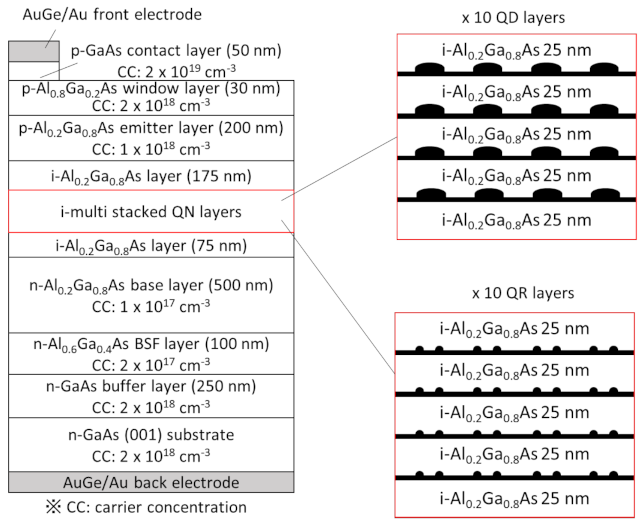
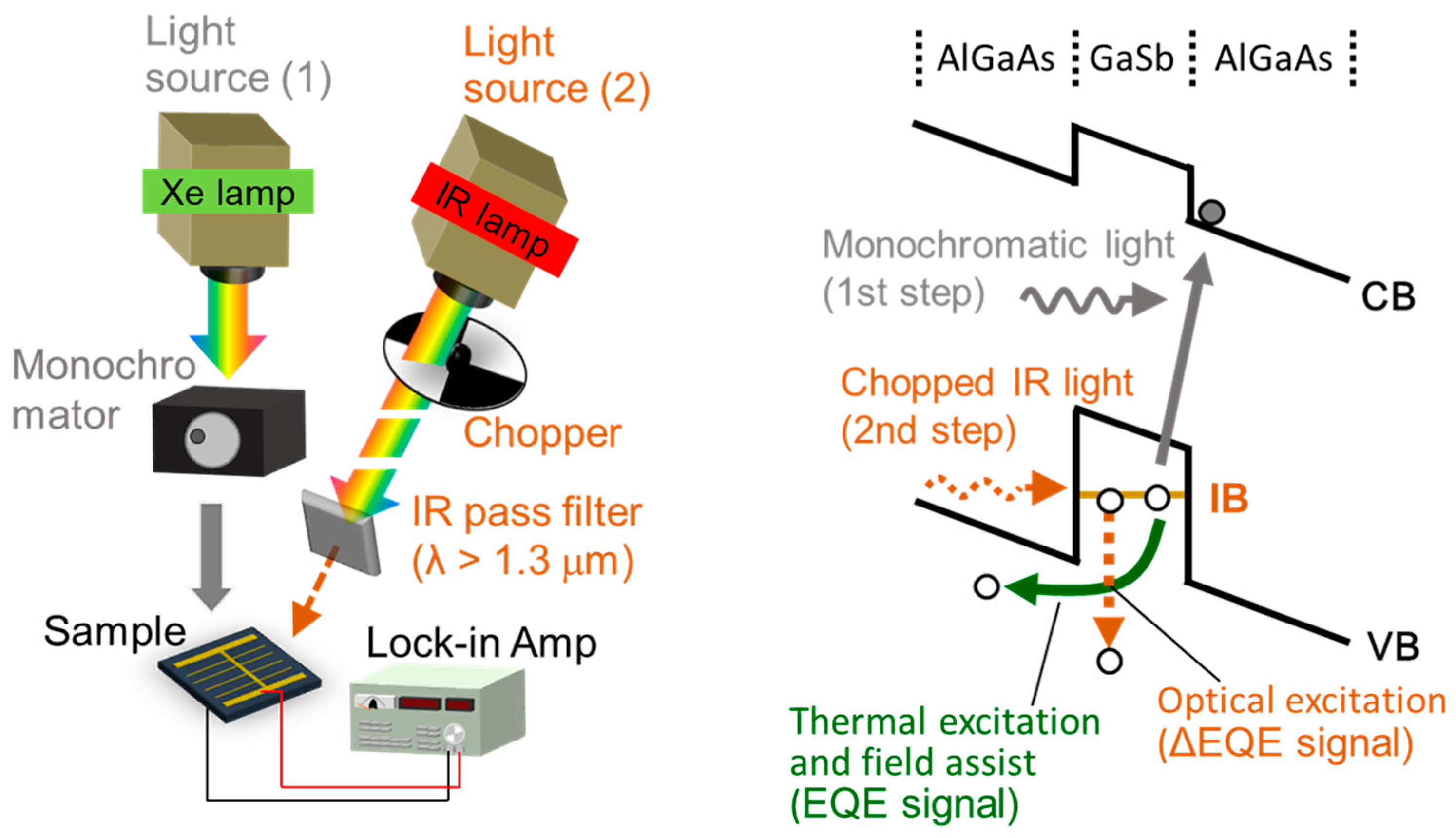
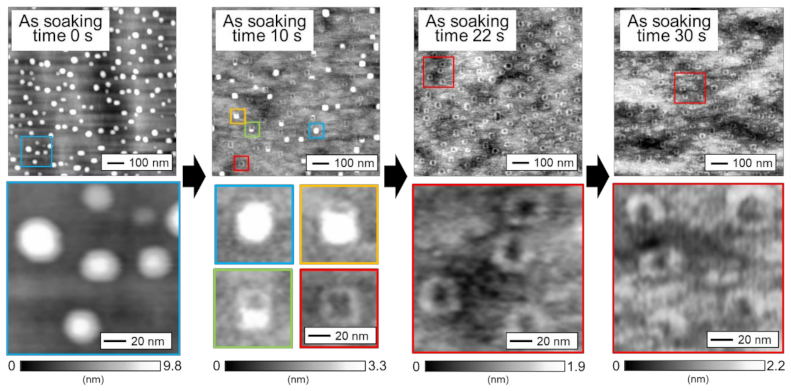

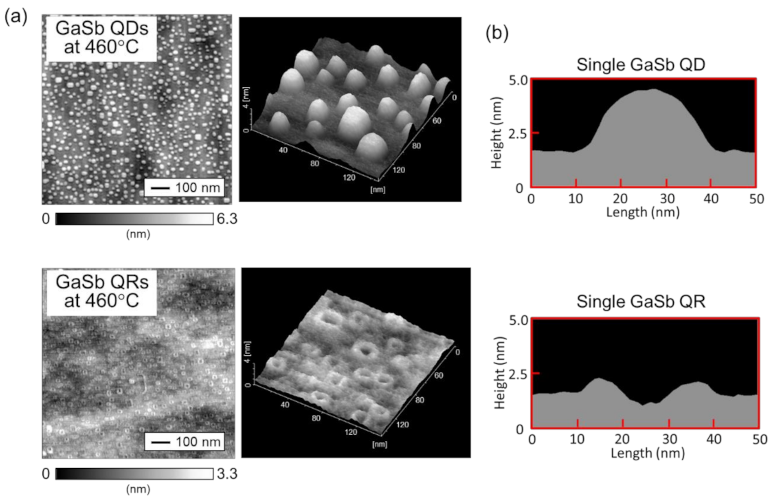
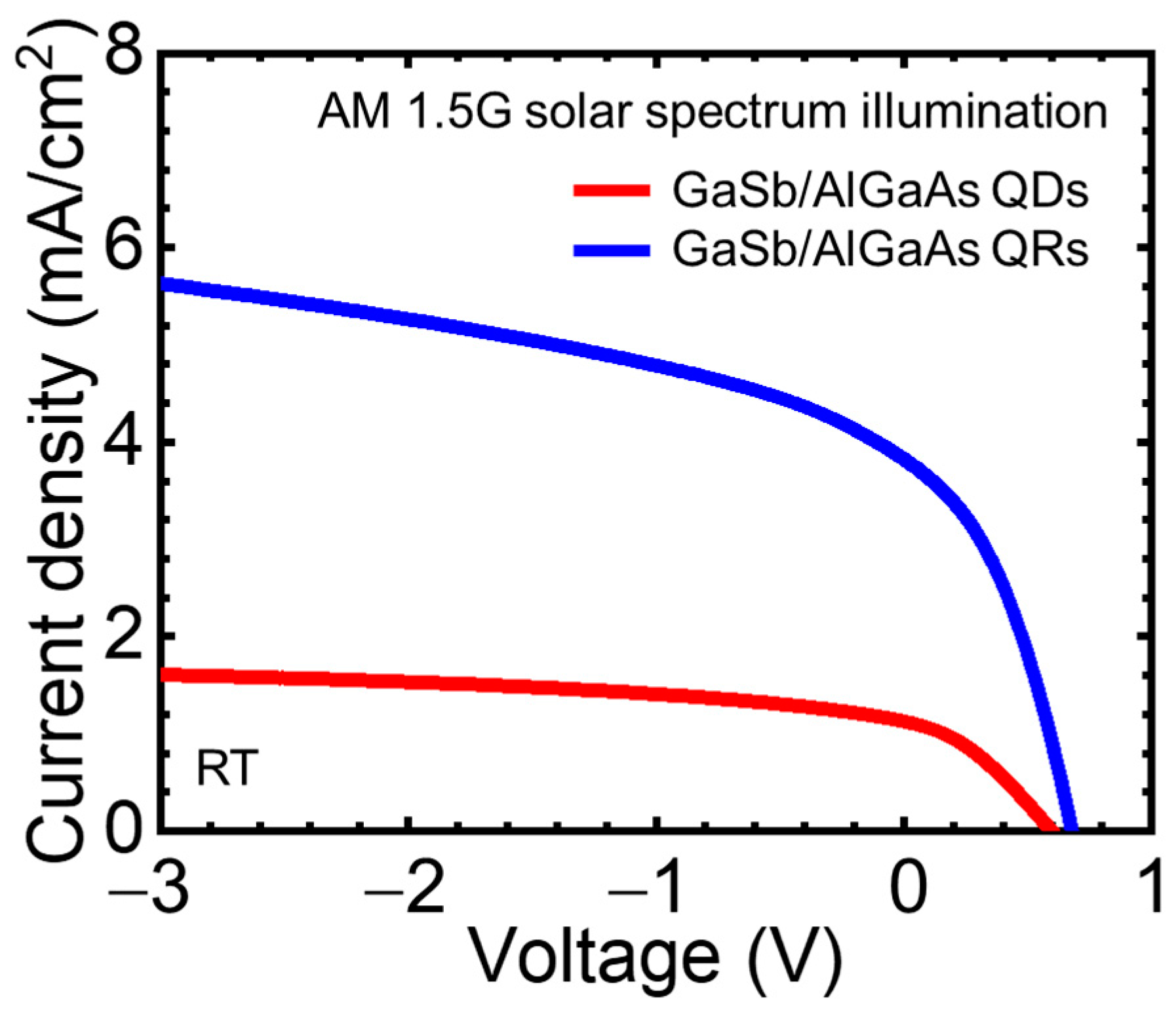
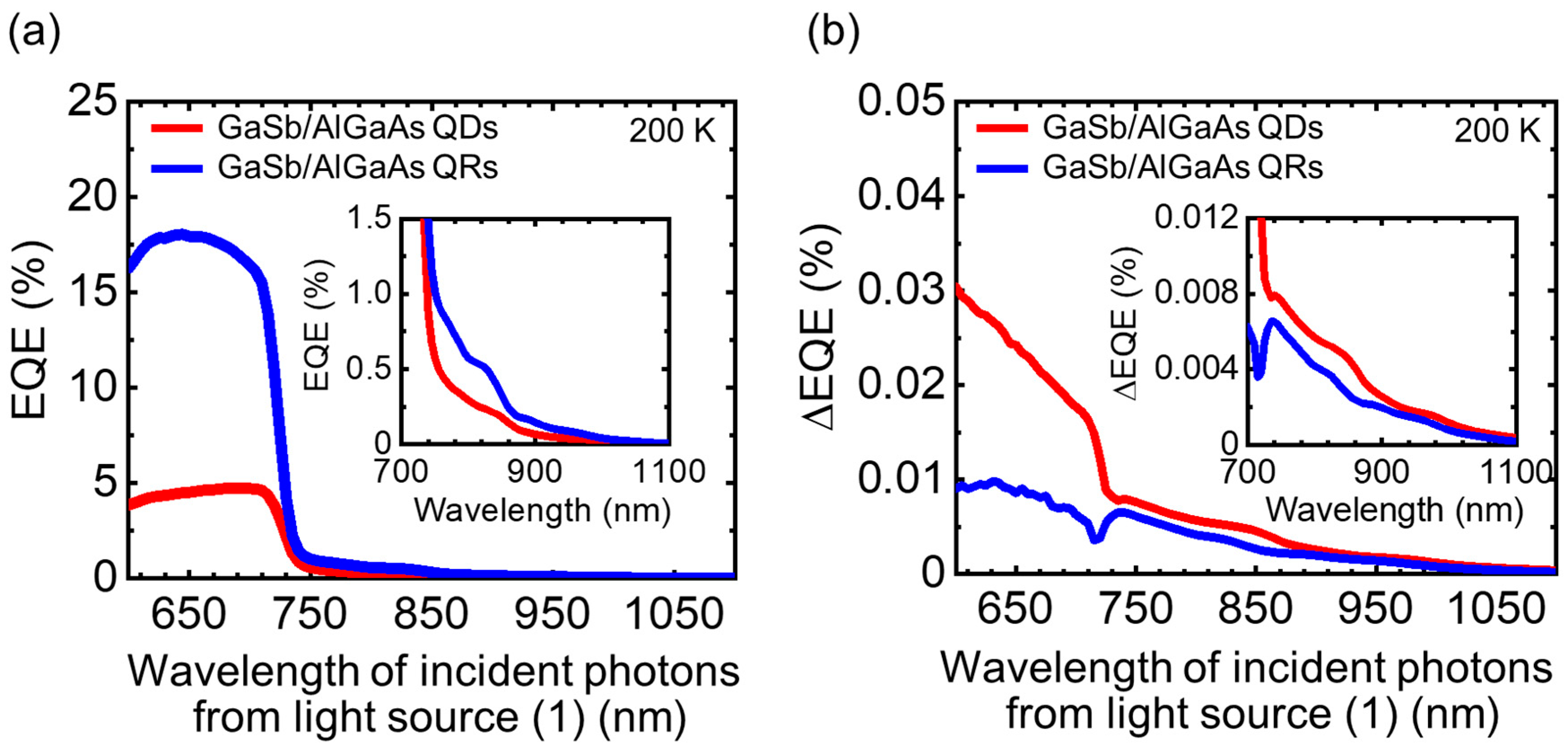
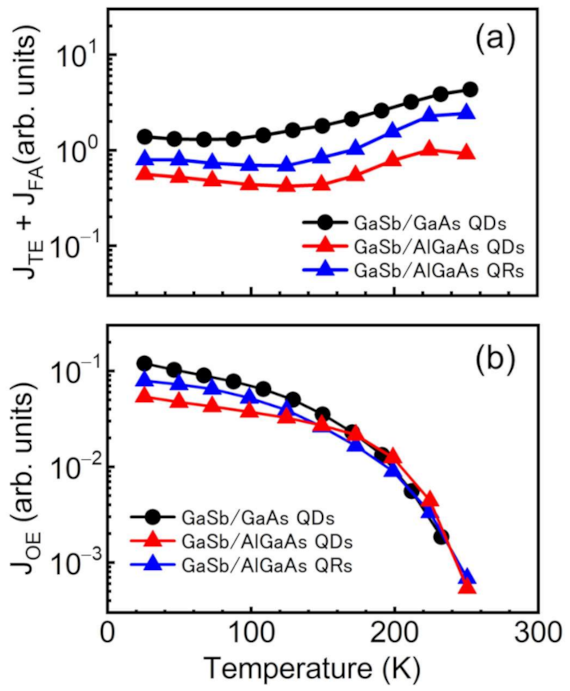
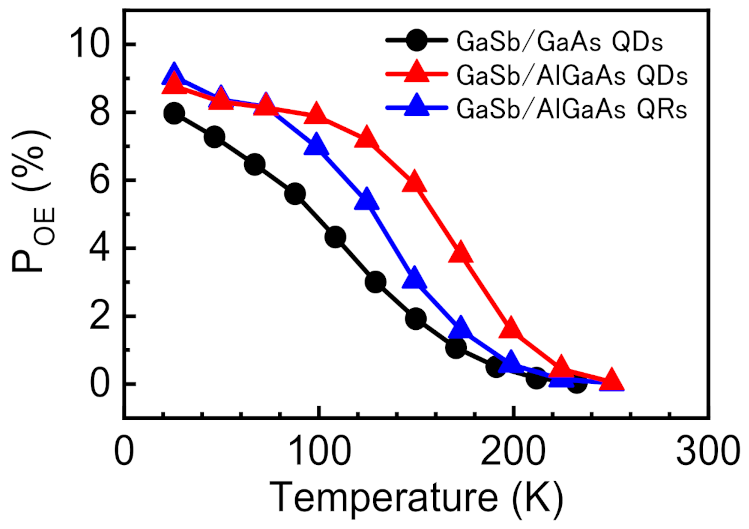
| Structure | Diameter (nm) | Height (nm) | Density (cm−2) |
|---|---|---|---|
| QDs | 27.84 | 2.56 | 7.7 × 1010 |
| QRs | 28.44 | 0.95 | 7.4 × 1010 |
| SC | JSC (mA/cm2) | VOC (V) | FF (-) |
|---|---|---|---|
| GaSb/AlGaAs QD | 1.13 | 0.596 | 0.351 |
| GaSb/AlGaAs QR | 3.83 | 0.679 | 0.389 |
Publisher’s Note: MDPI stays neutral with regard to jurisdictional claims in published maps and institutional affiliations. |
© 2021 by the authors. Licensee MDPI, Basel, Switzerland. This article is an open access article distributed under the terms and conditions of the Creative Commons Attribution (CC BY) license (http://creativecommons.org/licenses/by/4.0/).
Share and Cite
Shoji, Y.; Tamaki, R.; Okada, Y. Temperature Dependence of Carrier Extraction Processes in GaSb/AlGaAs Quantum Nanostructure Intermediate-Band Solar Cells. Nanomaterials 2021, 11, 344. https://doi.org/10.3390/nano11020344
Shoji Y, Tamaki R, Okada Y. Temperature Dependence of Carrier Extraction Processes in GaSb/AlGaAs Quantum Nanostructure Intermediate-Band Solar Cells. Nanomaterials. 2021; 11(2):344. https://doi.org/10.3390/nano11020344
Chicago/Turabian StyleShoji, Yasushi, Ryo Tamaki, and Yoshitaka Okada. 2021. "Temperature Dependence of Carrier Extraction Processes in GaSb/AlGaAs Quantum Nanostructure Intermediate-Band Solar Cells" Nanomaterials 11, no. 2: 344. https://doi.org/10.3390/nano11020344
APA StyleShoji, Y., Tamaki, R., & Okada, Y. (2021). Temperature Dependence of Carrier Extraction Processes in GaSb/AlGaAs Quantum Nanostructure Intermediate-Band Solar Cells. Nanomaterials, 11(2), 344. https://doi.org/10.3390/nano11020344






